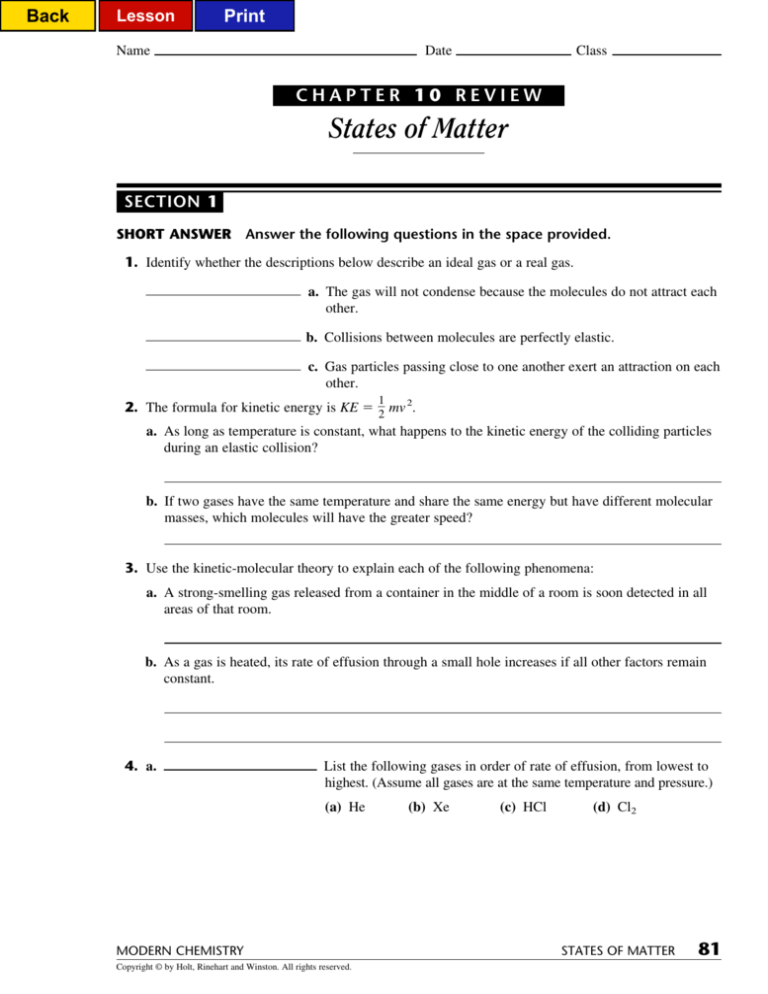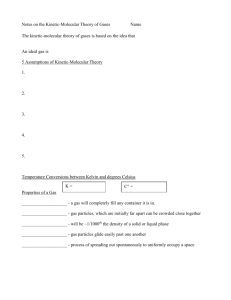
Back
Lesson
Print
Name
Date
Class
CHAPTER 10 REVIEW
States of Matter
SECTION 1
SHORT ANSWER
Answer the following questions in the space provided.
1. Identify whether the descriptions below describe an ideal gas or a real gas.
a. The gas will not condense because the molecules do not attract each
other.
b. Collisions between molecules are perfectly elastic.
c. Gas particles passing close to one another exert an attraction on each
other.
1
2. The formula for kinetic energy is KE 2 mv 2.
a. As long as temperature is constant, what happens to the kinetic energy of the colliding particles
during an elastic collision?
b. If two gases have the same temperature and share the same energy but have different molecular
masses, which molecules will have the greater speed?
3. Use the kinetic-molecular theory to explain each of the following phenomena:
a. A strong-smelling gas released from a container in the middle of a room is soon detected in all
areas of that room.
b. As a gas is heated, its rate of effusion through a small hole increases if all other factors remain
constant.
4. a.
List the following gases in order of rate of effusion, from lowest to
highest. (Assume all gases are at the same temperature and pressure.)
(a) He
MODERN CHEMISTRY
Copyright © by Holt, Rinehart and Winston. All rights reserved.
(b) Xe
(c) HCl
(d) Cl2
STATES OF MATTER
81
Back
Print
Lesson
Name
Date
Class
SECTION 1 continued
b. Explain why you put the gases in the order above. Refer to the kinetic-molecular theory to
support your explanation.
5. Explain why polar gas molecules experience larger deviations from ideal behavior than nonpolar
molecules when all other factors (mass, temperature, etc) are held constant.
6.
The two gases in the figure below are simultaneously injected into opposite ends of the
tube. The ends are then sealed. They should just begin to mix closest to which labeled point?
NH3
(a)
(b)
HCl
(c)
7. Explain the difference in the speed-distribution curves of a gas at the two temperatures shown in the
figure below.
Lower temperature
Number of molecules
Higher temperature
Molecular speed
82
STATES OF MATTER
MODERN CHEMISTRY
Copyright © by Holt, Rinehart and Winston. All rights reserved.
Back
Print
Lesson
Name
Date
Class
CHAPTER 10 REVIEW
States of Matter
SECTION 1
SHORT ANSWER
Answer the following questions in the space provided.
1. Identify whether the descriptions below describe an ideal gas or a real gas.
ideal gas
a. The gas will not condense because the molecules do not attract each
other.
ideal gas
b. Collisions between molecules are perfectly elastic.
real gas
c. Gas particles passing close to one another exert an attraction on each
other.
1
2. The formula for kinetic energy is KE 2 mv 2.
a. As long as temperature is constant, what happens to the kinetic energy of the colliding particles
during an elastic collision?
The energy is transferred between them.
b. If two gases have the same temperature and share the same energy but have different molecular
masses, which molecules will have the greater speed?
Those with the lower molecule mass.
3. Use the kinetic-molecular theory to explain each of the following phenomena:
a. A strong-smelling gas released from a container in the middle of a room is soon detected in all
areas of that room.
Gas molecules are in constant, rapid, random motion.
b. As a gas is heated, its rate of effusion through a small hole increases if all other factors remain
constant.
As a gas is heated, each molecule’s speed increases; therefore, the molecules pass
through the small hole more frequently.
4. a.
b, d, c, a
List the following gases in order of rate of effusion, from lowest to
highest. (Assume all gases are at the same temperature and pressure.)
(a) He
MODERN CHEMISTRY
Copyright © by Holt, Rinehart and Winston. All rights reserved.
(b) Xe
(c) HCl
(d) Cl2
STATES OF MATTER
81
Back
Print
Lesson
Name
Date
Class
SECTION 1 continued
b. Explain why you put the gases in the order above. Refer to the kinetic-molecular theory to
support your explanation.
All gases at the same temperature have the same average kinetic energy. Therefore,
heavier molecules have slower average speeds. Thus, the gases are ranked from
heaviest to lightest in molar mass.
5. Explain why polar gas molecules experience larger deviations from ideal behavior than nonpolar
molecules when all other factors (mass, temperature, etc) are held constant.
Polar molecules attract neighboring polar molecules and often move out of
their straight-line paths because of these attractions.
6.
c
The two gases in the figure below are simultaneously injected into opposite ends of the
tube. The ends are then sealed. They should just begin to mix closest to which labeled point?
NH3
(a)
(b)
HCl
(c)
7. Explain the difference in the speed-distribution curves of a gas at the two temperatures shown in the
figure below.
Lower temperature
Number of molecules
Higher temperature
Molecular speed
In both cases the average speed of the molecules is proportional to temperature. The
distribution of molecules becomes broader as the temperature increases. This
means that there are a greater number of molecules traveling within a greater range
of higher speeds as the temperature increases.
82
STATES OF MATTER
MODERN CHEMISTRY
Copyright © by Holt, Rinehart and Winston. All rights reserved.










